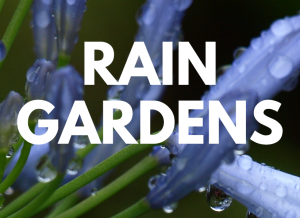[av_one_full first min_height=” vertical_alignment=” space=” custom_margin=” margin=’0px’ padding=’0px’ border=” border_color=” radius=’0px’ background_color=” src=” background_position=’top left’ background_repeat=’no-repeat’ animation=” mobile_display=”]
[av_textblock size=” font_color=” color=” custom_class=”]

Why should I make a rain garden?
By capturing runoff, raingardens prevent polluted stormwater from going down the storm drain and out to our rivers, ponds and bays. Rain gardens also help replenish our aquifers and groundwater-fed rivers and ponds by recharging rainwater into the ground rather than down the stormdrains. In fact, rain gardens absorb 30% more water than the same size area of lawn!
Create your own rain garden.
Follow these seven easy steps to make your very own rain garden. More detailed instructions and plans can be found at www.raingardens.org or www.raingardennetwork.com.
1) Choose a location. Pick a site for your garden that tends to collect water or where runoff from your driveway or downspout can be diverted into it. Your raingarden should be at least 10 feet away from building foundations, underground utilities, and septic system drainfields. Keep a 1-2 foot grass buffer between any downspouts and your garden to prevent washout.
2) Measure your garden. Your rain garden should be 20-30% of the drainage area it is treating. So, if you are treating runoff from your 1000 ft2 driveway, you want a 200-300 square foot garden. Rain gardens are versatile – they can be any shape you want, from a regular rectangle to an amorphous blob. It should be graded slightly so water flows towards the center, about six inches lower in the center than the edges.
3) Check the drainage. It is important that your rain garden drains quickly. Determine if water can infiltrate fast enough by digging a hole approximately 8 inches deep and pouring in a few inches of water. If the water drains slower than an inch an hour, you will need to add a layer of gravel to the bottom of your raingarden (at least 6 inches).
4) Prepare your soil. Soils on the South Shore tend to be sandy, which is good because most can simply be improved by loosening them and mixing them with some compost. The ideal soil is a mix of two parts sand, one part topsoil (no clay), and one part compost. Loosen the soil to a depth of 2 feet.
5) Choose your plants. Select a variety of native, low-maintenance flowers and grasses that will provide color and interest throughout the seasons and can tolerate both wet and dry conditions (remember the rain garden will fill with rainwater periodically). Consider light and water preferences of the plants – some will thrive in sun, others shade; some prefer the drier edges of the garden, others may thrive in the soggy center. Group the plants together for the most impact, and estimate one small plant per square foot. Use our suggested raingarden plan or check out these seven raingarden plans from the City of Maplewood MN.

6) Plant your garden. This is the fun part! You may want to create a grid of string if you are following a gridded plan. Remove each plant from its pot, break up the root ball slightly, and gently press it into its designated location. Be careful not to walk on the prepared soil or you will compact it. Once all your plants are in their new home, give your garden a good drink of water.
7) Add mulch. A 2-3 inch layer of shredded hardwood mulch is necessary to keep the soil moist and ready to soak up rain, and it helps reduce weeds. Chipped bark mulch tends to float when flooded.
Caring for your garden.
For the first two or three weeks, water plants about every other day until they show they are growing and doing well. After they are well-established with deep roots, they won’t need additional watering. Keep the garden free of debris that might affect drainage and weeds that could overtake it. If there are parts of the garden that seem to be eroding from too much flow, use stones to divert and spread out the water entering the garden.
What about mosquitoes?
Mosquitoes won’t find rain gardens to be good breeding areas because if a rain garden is properly constructed the water will drain within 24 hours (but usually within an hour or two). The Culex mosquito, the primary variety that transmits West Nile virus to humans, prefers to breed in small containers of water that remain stagnant for at least 10 days at a time.
Visit a rain garden.
There are many places in coastal Massachusetts where you can see rain gardens in action! Here are just a few:
Cohasset: Water Treatment Plant at 339 King St.; plus various locations along Pond St, Arrowood St., Evergreen Lane, King St.
Hull: Weir River Estuary Center
Ipswich: Ipswich River Watershed Association’s headquarters (143 County Road, Ipswich)
Marshfield: Town Hall parking lot, 870 Moraine St.
Plymouth: Town Hall, 11 Lincoln St. (container rain gardens); Stephens Field, around the corner from Town Hall; Plimoth Plantation (adjacent to the lower bus parking lot)
Scituate: Scituate High School (by the playground); Hughey Rd. (just before the end of the road)
Wilmington: Eleven gardens along Silver Lake Avenue, near Silver Lake Beach
Want more information about rain gardens?
- Greenscapes Rain Garden Brochure
- Raingardens (Prepared by GeoSyntec Consultants, Boxborough, MA)
- http://nemo.uconn.edu/raingardens/
- Rainwater Gardens (Lakewood, MN)
- Rain Garden Manual of New Jersey
- Check out one of our very own Greenscapes professionals planting a raingarden on This Old House.
[/av_textblock]
[/av_one_full]
